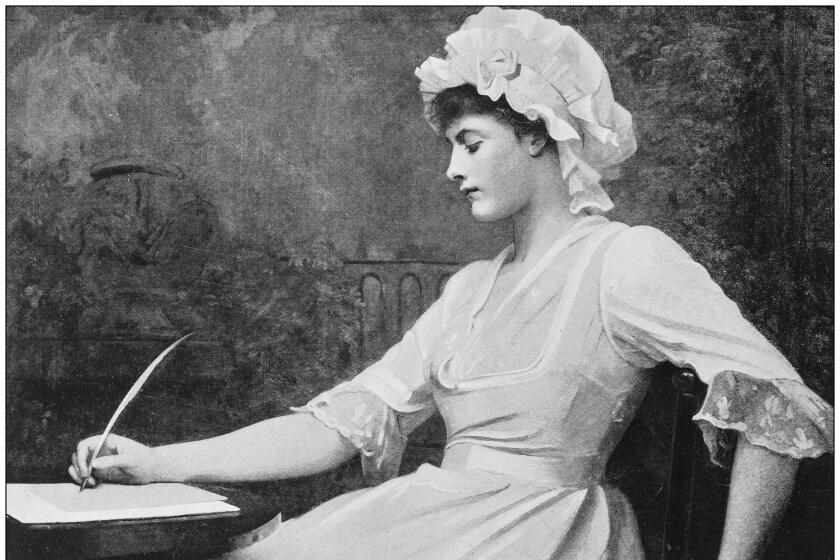Celia Paul is finally her own muse in the dazzling memoir ‘Self-Portrait’
- Share via
On the Shelf
Self-Portrait
By Celia Paul
NYRB Books: 215 pages, $30
If you buy books linked on our site, The Times may earn a commission from Bookshop.org, whose fees support independent bookstores.
I first read about the English painter Celia Paul in an essay by Rachel Cusk published last year, “Can a Woman Who Is an Artist Ever Be Just an Artist?” The title is purposefully provocative. Paul’s art stands to argue that the answer is an unequivocal yes. But her memoir, “Self-Portrait,” reveals a more complicated response.
It’s no surprise that much of the writing about this book and Paul’s work introduces her through her connection to one of the major artists of the 20th century. Lucian Freud was 54 and already an established painter when he met Paul, then an 18-year-old student at London’s Slade School of Fine Art. After an inspiring prologue on her philosophy of art-making, Paul begins her memoir with a chapter titled “Lucian.”
The two were involved for 10 years and share a son together. Her description of their first physical encounter is unsettling. But it was Paul who approached Freud in the studio. Noticing his nervousness, “I went up to him and asked him if he was busy ... I showed him the charcoal drawings I had done of my mother.” Though Paul would often act as muse and model for Freud, she had established herself from their very first meeting as an artist.
“Women have too often been seen as subjects of art, rather than artists,” she writes. “Their natural propensity for giving themselves up to the experience, combined with an aptitude for stillness, has made many women great muses to great male artists.” Her own experience sitting for Freud, usually naked, was fraught. She would often weep through their sessions. But that is the duality of Paul’s life: She experiences art both as a woman and an artist. The two identities are inextricable from one another, and the tension between the two poles is electric.
Paul’s muse was her mother, Pamela. She describes their daily schedule during visits home from art school: “My mother woke me every morning with a cup of tea soon after five. She would then sit for me for three hours before it was time for her to join my father for morning prayers ... She would have breakfast with him and then sit for me until lunchtime. In the summer, while the light lasted, she would sit for me again in the afternoons.”
Novelist Lynn Steger Strong on the revolutionary passivity of Rachel Cusk, Ottessa Moshfegh and Sally Rooney — how we’ve misread them and what comes next.
Pamela would use the silent time for prayer. “What a gift for a Christian,” she said. What a gift for the artist.
Paul was born in India to British missionaries. After the family moved back to England, “the beauty of the surroundings had been what inspired me to be an artist, as well as being driven to it by the lack of privacy,” Paul writes. With the church community and then boarding school governing her youth, “painting became my way of guarding and controlling my inner life.”
Through an intense and somewhat competitive friendship with another girl at boarding school, Paul realized she was an artist. On seeing her rival’s secret work, “the surge of jealousy I felt was sickening and I thought I was going to pass out.” Over a school holiday, she worked feverishly on drawings and paintings. Her teacher was thrilled and recommended her for art school.
As a teenager, she painted above the family’s sitting room, and if her sisters were being too loud downstairs, she would bang her feet on the floor to quiet them. “They always obeyed and I had no feelings of guilt at being so bossy and demanding.” Even in the way Paul frames this sentence, the struggle of the female artist is present. She has no guilt about being rude, yet she describes her actions as “bossy.” Male artists shirk major responsibilities in service of their art, but when Paul asks for quiet, she is being “demanding.”
When her son, Frank, was born, Paul was overwhelmed with love for him. She was distraught when she realized she would have to wean him so she could work at the studio. And yet, she demanded total solitude. Even now that Paul is married, she and her husband, Steven Kupfer, live separately. “He doesn’t have a key to my flat.” Even now, when her adult son is visiting, she is resigned to the fact that the two sides of her identity cannot be joined. “When I am with Frank I don’t have any thoughts for myself,” she writes.
Heather Clark fuses new discoveries and eye-opening analysis in an inspiring biography, “Red Comet: The Short Life and Blazing Art of Sylvia Plath.”
Freud bought Paul a flat in Bloomsbury in 1982, but she didn’t work there until she started living there permanently, after her father’s death. Her mother became her son’s full-time caregiver and remained so until he went to school, and her relationship with Freud cooled. “Something in me had changed. I felt more powerful and confident since becoming a mother. I was beginning to have more of a sense of who I was.”
Freud completed his last painting of Paul after her very successful first exhibition. In his work, she appears as the painter of a nude male model. “I felt honored that Lucian should represent me in the powerful position of the artist … But underlying my pride, I felt wistful that I was no longer represented as the object of desire.” Paul and Freud ended their romance in 1988.
Paul may have outgrown her musehood, but her mother never did. Even though Paul’s studio was only accessible via 80 steps, the elderly Pamela would still travel from Cambridge two days a week to sit for her. “She was always very disheveled and breathless on arrival,” Paul writes. But “she was always ecstatic if she felt she had sat well.” Finishing at 12:30 p.m., Paul would watch her mother slowly descend the stairs and see her walking down Great Russell Street, and then “I would lose sight of her.”
Pamela died in 2015 at age 87. Paul lost not only her mother but also her muse. “The last coherent words she said to me were: ‘It is Celia, isn’t it?’”
Her mother was her ultimate subject. “The drawings that I had shown Lucian ... were the first true works of art I had made, because they were of my mother,” Paul emphasizes. “They were necessary because I loved her. Their necessity gave them their force.” Though the artist must sometimes keep her two identities separate so she can work, her fierce attachment with her mother creates the most transcendent artwork. Pamela’s hands, the light on her face, the way she curls against a landscape of the English countryside like a sleeping giant, have a deeply religious feeling to them. As her mother shrinks with age, Paul continues unflinchingly, as only an artist could.
Jenn Shapland’s “My Autobiography of Carson McCullers” and Mark Doty’s “What Is the Grass,” about Walt Whitman, are hybrid memoir-biographies.
“Self-Portrait” is a beautifully written bildungsroman, a “portrait of the artist” as a young woman. It is also, more uniquely, a powerful resource for artists who face the dueling responsibilities of creation and caregiving. You don’t have to be a woman or a mother to feel this friction. The last few pages of “Self-Portrait” are reproductions of Paul’s paintings of the view of the British Museum from the flat where she still lives and works. Paul’s younger sister, Kate, has replaced her mother as a frequent sitter, but Paul has turned to a new muse: “I am my own subject.”
Ferri’s most recent book is “Silent Cities: New York.”
More to Read
Sign up for our Book Club newsletter
Get the latest news, events and more from the Los Angeles Times Book Club, and help us get L.A. reading and talking.
You may occasionally receive promotional content from the Los Angeles Times.











